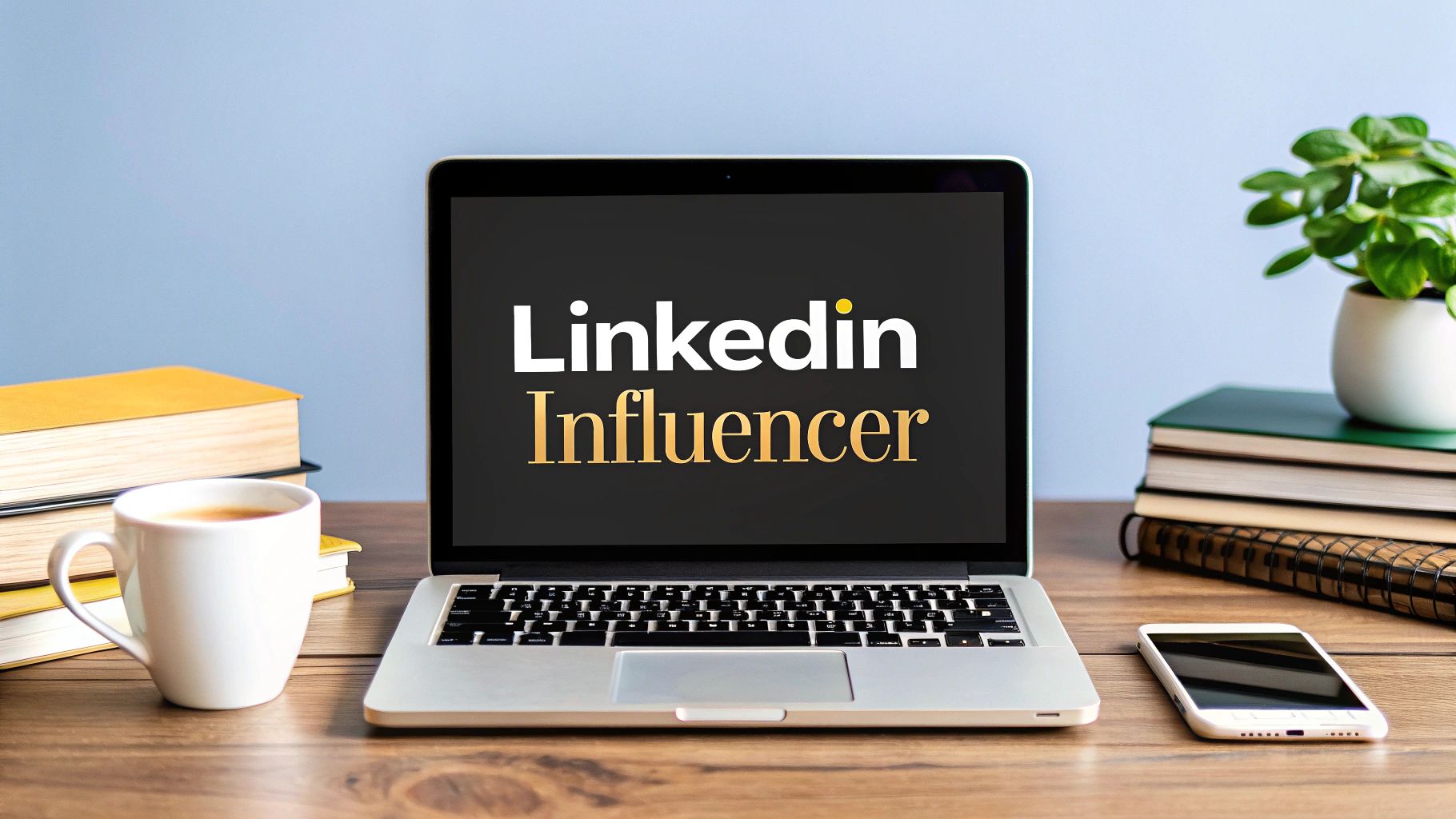
How to Become a LinkedIn Influencer: Your Complete Roadmap
Published on 2025-06-24
Finding Your Authentic Voice in the Professional Arena
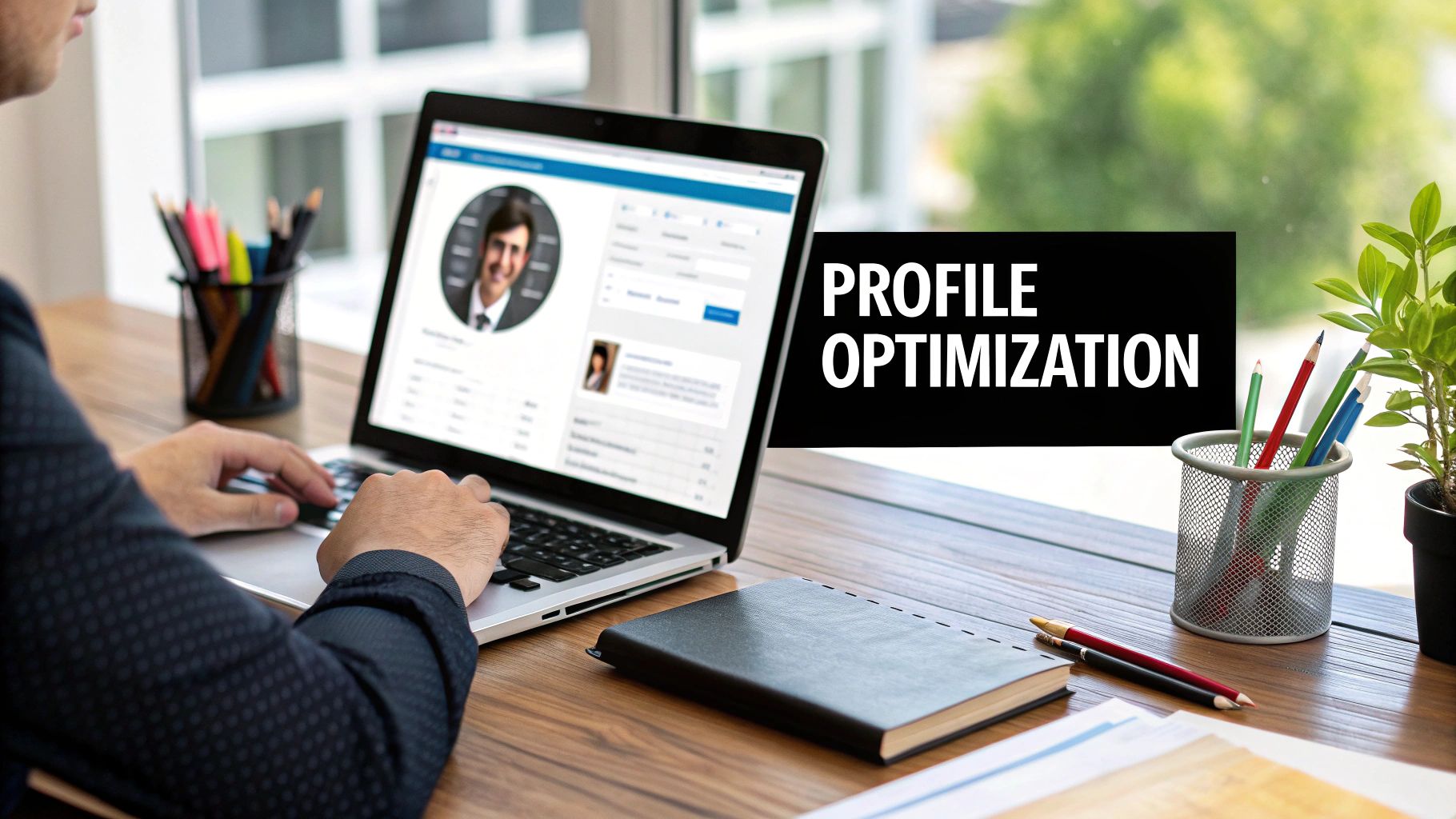
The road to becoming a LinkedIn influencer isn't about copying the style of the biggest names in your field. Real influence comes from authenticity—it’s that sweet spot where your expertise, unique perspective, and your audience's needs all meet. If you try to be everything to everyone, you'll just end up blending into the background. The goal is to carve out your own specific corner of the professional world.
This process starts with a bit of self-reflection. Ask yourself: What problems can I solve better than almost anyone else? What topics make me light up, the kind I’d happily discuss even if no one was listening? Your best content will always come from a place of genuine passion and hands-on experience. This is how you build a personal brand that feels genuine because it truly is.
Identifying Your Unique Niche
To really make an impression, you need to get specific. Calling yourself a "marketing expert" is far too broad. Instead, could you be the go-to person for B2B SaaS marketing analytics? Or maybe you specialize in personal branding for founders of early-stage startups. The more defined your niche is, the easier it becomes to attract a loyal following that views you as an indispensable resource.
To help you zero in on your focus, think about these questions:
- What are the specific, daily challenges that people in my target profession run into?
- Is there common advice in my industry that I completely disagree with? Why?
- What unique experiences or case studies can I share that nobody else can?
Answering these helps you pinpoint the exact value you bring to the table. It’s not just about sharing information; it’s about offering a distinct point of view that solves a specific problem for a specific group of professionals.
This focused strategy is particularly powerful on LinkedIn. With over 1.2 billion members worldwide and a staggering 1.77 billion visits in February 2025 alone, the platform is a beehive of professional activity. A solid 43% of consumers are on LinkedIn, and the key demographic of users aged 25-34 is actively looking for high-value content. This gives you a fantastic opportunity to connect with an audience that's ready and willing to engage with what you have to say. You can dig deeper into these trends and read the full research about LinkedIn's powerful user base.
To help you structure this foundational work, here’s a checklist that breaks down the key elements, their priority, the time you should expect to invest, and the impact they'll have.
| Foundation Element | Priority Level | Time Investment | Expected Impact |
|---|---|---|---|
| Defining Your Niche | High | 2-4 hours | High (Attracts a dedicated, relevant audience) |
| Identifying Your Unique Perspective | High | 1-3 hours | High (Differentiates you from competitors) |
| Understanding Audience Pain Points | Medium-High | 3-5 hours (ongoing) | High (Ensures content is relevant and valuable) |
| Crafting Your Core Message | Medium | 2-3 hours | Medium (Provides a consistent theme for your content) |
This table shows that the initial, high-priority work of defining your niche and perspective doesn't have to take weeks, but it's absolutely crucial for long-term impact.
Ultimately, your authentic voice is your most powerful tool on the path to becoming a LinkedIn influencer. It’s the solid ground on which you’ll build a compelling profile, create content that connects, and grow a community that truly trusts your insight.
Building a Profile That Opens Doors
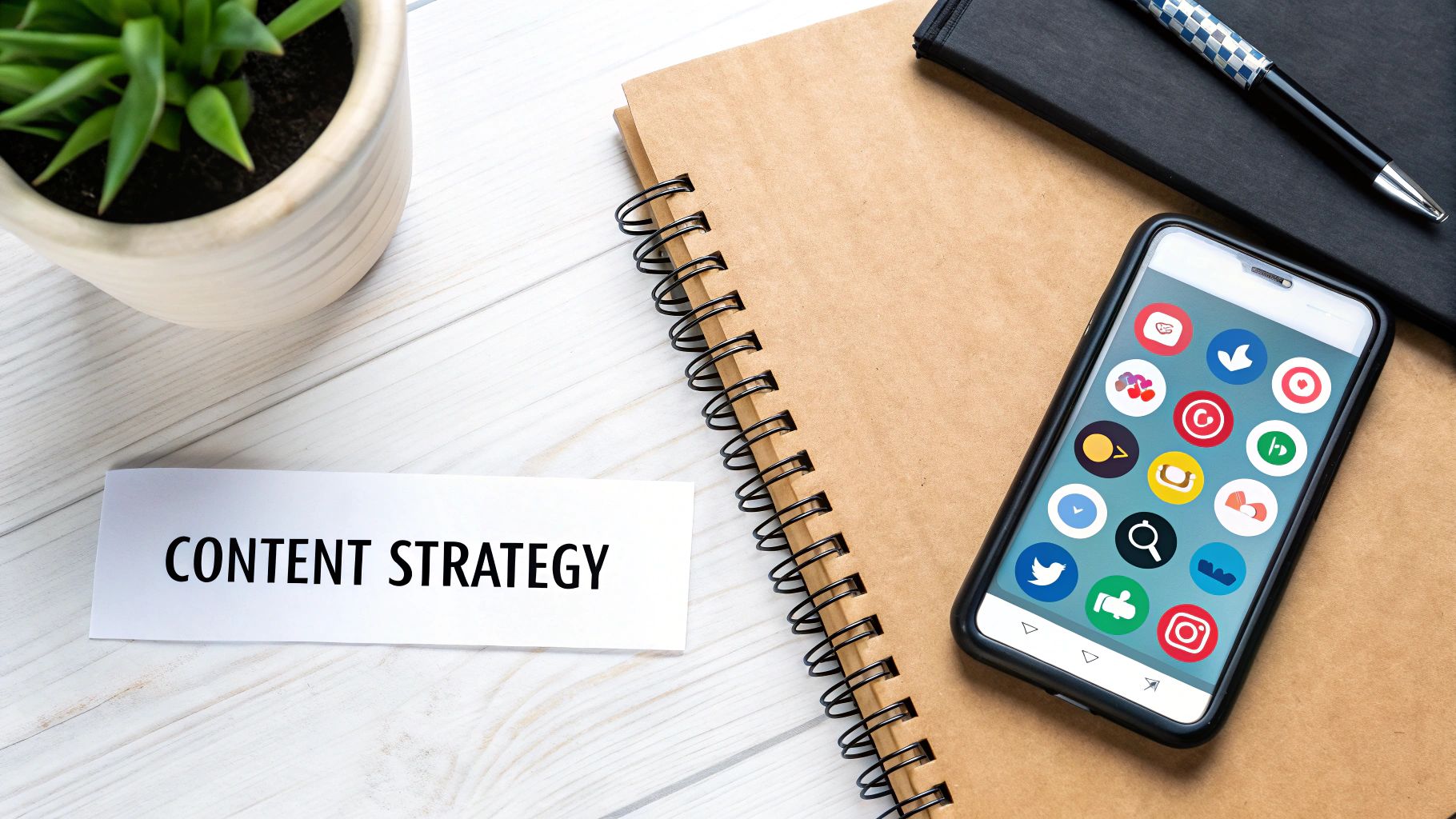
Think of your LinkedIn profile as your personal marketing agent that works for you 24/7. Is it just a digital list of your past jobs, or is it actively bringing you new opportunities and followers? The difference between a static resume and a magnetic profile comes down to strategic storytelling and a bit of optimization. To really make an impact on LinkedIn, your profile needs to do more than just exist—it has to turn casual visitors into true believers.
You have about five seconds to make an impression when someone lands on your profile. In that time, they'll see your photo, your banner, and your headline. If these elements don't immediately spark their interest and show your credibility, you've probably lost them. Your headline is your digital handshake, and it’s some of the most valuable real estate on the platform. Don't just settle for a generic job title. Instead of "Marketing Manager at XYZ Company," try something that shows your value, like, "I Help B2B Tech Startups Go from Obscurity to Industry Leaders | SaaS Marketing & Growth Strategy." This tells people exactly who you help and how you do it.
Crafting a Compelling Narrative
Your "About" section is where you can build a real connection. This is your opportunity to show off your expertise without using dry, corporate language. Tell a story. What gets you excited about your work? What’s your professional mission? Sharing a quick anecdote or a core belief that guides your work makes you more human and relatable.
A well-written profile is your ticket to joining a community of influential professionals. Thought leadership is huge right now, and LinkedIn reports having over 180 million senior-level influencers on its platform. This massive group of decision-makers in finance, tech, and other key industries makes it the ideal place to build genuine credibility. You can find more details about the rise of senior influencers on ColumnContent.com.
Activating Key Profile Features
Once you've got your story straight, it's time to flip some switches that many people ignore. If you're serious about creating content, you absolutely need to activate Creator Mode. This is a non-negotiable step.
Here’s why activating Creator Mode is so powerful:
- It switches your primary call-to-action button from "Connect" to "Follow," which helps you grow your audience much faster.
- It lets you feature up to five "Talks about" hashtags, immediately signaling your key areas of expertise to visitors and the algorithm.
- You gain the ability to add a featured link right under your headline, which is perfect for sending traffic to your newsletter, website, or personal portfolio.
Turning on these features tells both the LinkedIn algorithm and your visitors that you're here to provide value. This simple adjustment is a fundamental step on your path to becoming a recognized voice on LinkedIn. For a more detailed walkthrough, take a look at our guide on how to build your personal brand on LinkedIn.
Creating Content That Actually Matters to Your Audience
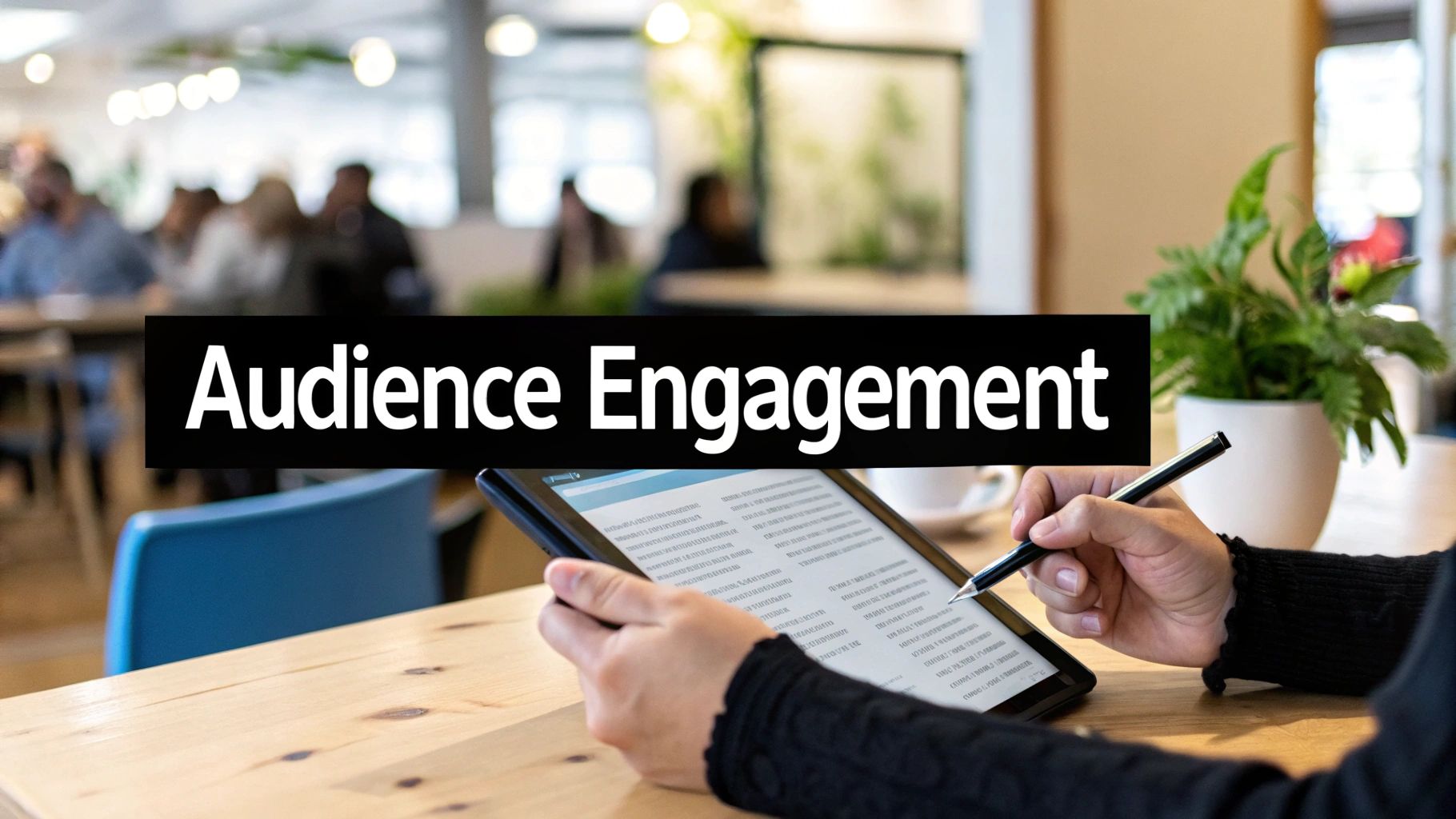
The LinkedIn feed is a nonstop flow of professional news, personal updates, and industry takes. Your job is to create something that makes people pause their endless scrolling and actually think or comment. This is a common hurdle for aspiring influencers—they get caught up in posting often but forget about posting with purpose. Your path to becoming a LinkedIn thought leader is built on consistently sharing valuable content that resonates with your audience's professional lives.
This means you have to go beyond bland, generic tips and share your own unique point of view. The most powerful content sits at the crossroads of your expertise, your personal experiences, and your audience’s biggest challenges. It's the difference between stating "Networking is important" and telling a real story about a single conversation that altered your career path, complete with steps others can take.
The Pillars of High-Value Content
So, what should you actually post? I find it helpful to think about content in three main pillars. This approach helps create a balanced and engaging feed, showing you're a well-rounded expert, not just someone who talks about one thing.
- Pillar 1: Educational Insights: This is how you build your authority. Share detailed "how-to" guides, demystify complicated industry trends, or present a fresh take on a common practice. This content needs to be practical, helping your audience improve at their jobs or see their field in a new light.
- Pillar 2: Personal Stories & Lessons: People connect with other people, not with faceless professional accounts. Don't be afraid to share your wins, your stumbles, and the lessons learned from both. A story about a project that went off the rails and how you fixed it is often far more relatable and useful than a tale of effortless success.
- Pillar 3: Community Engagement: Use your platform to spark conversations. Pose thought-provoking questions, run polls on hot topics, and share insights from others in your network. This positions you as a community hub, not just a broadcaster shouting into the void.
Working with the Algorithm, Not Against It
Understanding what types of content LinkedIn tends to favor can give you a real advantage. The platform's growth has been immense; between 2019 and 2025, LinkedIn’s user base is projected to nearly double, from 644 million to over 1.15 billion users. This huge audience is hungry for more engaging media. In fact, 2024 saw a 34% jump in video content uploads, which clearly shows a move toward more visual storytelling. For more great data points, you can explore Cognism's detailed LinkedIn statistics.
To help you decide where to focus your efforts, here’s a breakdown of how different content formats typically perform on LinkedIn.
LinkedIn Content Performance by Format
Comparison of engagement rates and reach for different LinkedIn content formats based on recent platform data
| Content Format | Average Engagement Rate | Reach Potential | Best Use Case |
|---|---|---|---|
| Text-Only Posts | 1.2% - 1.8% | Moderate | Sharing quick thoughts, asking questions, and starting conversations. Great for storytelling. |
| Posts with Images | 2.0% - 2.5% | High | Grabbing attention, illustrating a point, or sharing data visualizations. |
| Carousels (PDFs) | 3.5% - 5.0% | Very High | Breaking down complex topics, creating mini-guides, or showcasing a portfolio. |
| Native Video | 2.5% - 4.0% | High | Demonstrating a process, sharing personal stories, or conducting short interviews. |
| Polls | 4.0% - 6.0% | Moderate | Gathering quick audience feedback, sparking debate, and boosting immediate engagement. |
| Articles | 0.5% - 1.0% | Low to Moderate | In-depth analysis, establishing deep subject matter expertise, and SEO benefits. |
The data shows that while simple text posts are effective for conversation, richer formats like carousels and images often see higher engagement.
This doesn't mean you need to become a full-time video editor. It just shows that mixing up your content—using text, carousels, videos, and images—is a solid approach. Each format appeals to different people and serves a unique purpose. The goal is to find a content mix that you can maintain and that feels authentic to you. If you're looking for more tips on crafting posts that connect, you might find our guide on how to write engaging LinkedIn posts useful. At the end of the day, creating content that matters is about generously sharing what you know to help others get ahead.
!## Engaging Like a Human, Not a Bot
Creating great content is a huge part of building your presence on LinkedIn, but it’s really only half the story. The other, arguably more important, half happens in the trenches: the comment sections and direct messages where you build actual relationships. True influence isn’t about broadcasting your message; it’s about engaging in a way that feels real and adds something to the conversation.Let’s be honest, generic "Great post!" comments are the digital equivalent of a limp handshake. They're forgettable. Instead, your goal should be to leave comments that are like mini-posts themselves. Think of it as extending the conversation. If someone shares a post about project management, don't just agree. Add your own quick story about a related experience or ask a sharp follow-up question. This shows the original poster you actually read and processed their content, and it also positions you as a thoughtful peer to everyone else reading.
And here’s a non-negotiable rule: reply to every single comment on your own posts. This is critical. It builds a sense of community around your content and also signals to the LinkedIn algorithm that your post is sparking genuine conversation, which can seriously boost its reach.
Scaling Authenticity with Strategic Conversations
As your network expands, having deep, meaningful conversations with every single person becomes impossible. This is where you need a smart approach—a system to be strategic without losing that human touch.
A practical tactic is to identify a core group of people you want to build stronger ties with. This could include peers, mentors, or followers who show high potential for collaboration. Dedicate just 15-20 minutes each day to engaging specifically with their content. This focused effort ensures you're nurturing the relationships that will matter most to your growth.
Direct messages (DMs) are your other secret weapon, but they must be used for connection, not just pitching. Keeping your inbox organized is key to managing these conversations without feeling swamped.
When you do reach out, make it personal. Reference a recent post they shared or a common interest. Instead of a generic connection request, try something like this:
"Hi [Name], I really appreciated your recent post on [topic]. The point you made about [specific detail] made me rethink my own approach. I’d love to connect and follow your work."
This approach demonstrates genuine interest and lays the groundwork for a real professional relationship, turning a connection from just another number into a valuable contact.
Smart Networking That Amplifies Your Message
The most successful LinkedIn influencers know a secret: amazing content is only half the story. To truly make an impact, you need to amplify that content through smart networking. This isn't about sending a hundred connection requests and hoping for the best. It's about building real relationships that carry your message far beyond your immediate circle. This is how you go from being just another content creator to a recognized voice in your industry.
It all begins with a change in perspective. Instead of thinking, "What can this connection do for me?" ask yourself, "How can I bring value to this person and their audience?" When you find an industry leader you want to connect with, don't just send a generic request. Instead, find a recent post or article they wrote, and share a genuine insight it gave you. This approach shows you're a peer with valuable thoughts to share, not just someone with an agenda. Building mutual value is the bedrock of any strong professional relationship.
Expanding Your Reach Through Strategic Alliances
One of the quickest ways to grow your influence is by teaming up with others. Look for creators in your niche who cater to a similar audience but aren't your direct competitors. You could co-host a LinkedIn Live, write a guest piece for their newsletter, or even just make a pact to regularly share and comment on each other's posts. These collaborations introduce your expertise to a fresh, relevant audience that's already interested in what you have to say.
Another powerful, and often underused, tactic is getting active in LinkedIn Groups. These are focused communities where professionals are actively discussing industry challenges and looking for answers. The goal here isn't to just drop links to your latest content. It's about becoming a helpful, contributing member of the conversation.
Here’s a peek at the LinkedIn Groups discovery page, where you can search for communities in your field. By joining the right groups and participating consistently, you can establish yourself as a go-to expert and connect with highly engaged professionals.
For instance, if you're a marketing automation specialist, you might join groups for SaaS founders or digital agency owners. By consistently offering helpful advice and answering questions, you build credibility and attract followers who are specifically looking for your type of expertise. This creates a targeted pipeline of followers who are genuinely interested in your work. Meaningful participation in these groups is what turns strangers into dedicated followers. Always remember to be a resource first and a promoter second.
Measuring What Matters and Scaling Intelligently
Let's be honest, those vanity metrics feel great. Seeing a post rack up hundreds of likes gives you a nice little dopamine hit. But chasing likes and followers without a clear strategy is a common trap that won't build a sustainable career. The journey to becoming a real influencer on LinkedIn is a marathon, and you need a good map—which, in this case, is your data.
Moving Beyond Vanity Metrics
It's tempting to get excited about a post that gets a ton of likes, but what does that number really tell you? Did those likes come from potential clients and industry peers, or just random connections outside your target audience? True influence isn't just about quantity; it's about the quality of your engagement. A post with 50 likes but 15 thoughtful comments from leaders in your field is far more valuable than one with 500 likes and two generic "great post!" comments.
This is where your LinkedIn Analytics dashboard becomes your best friend.
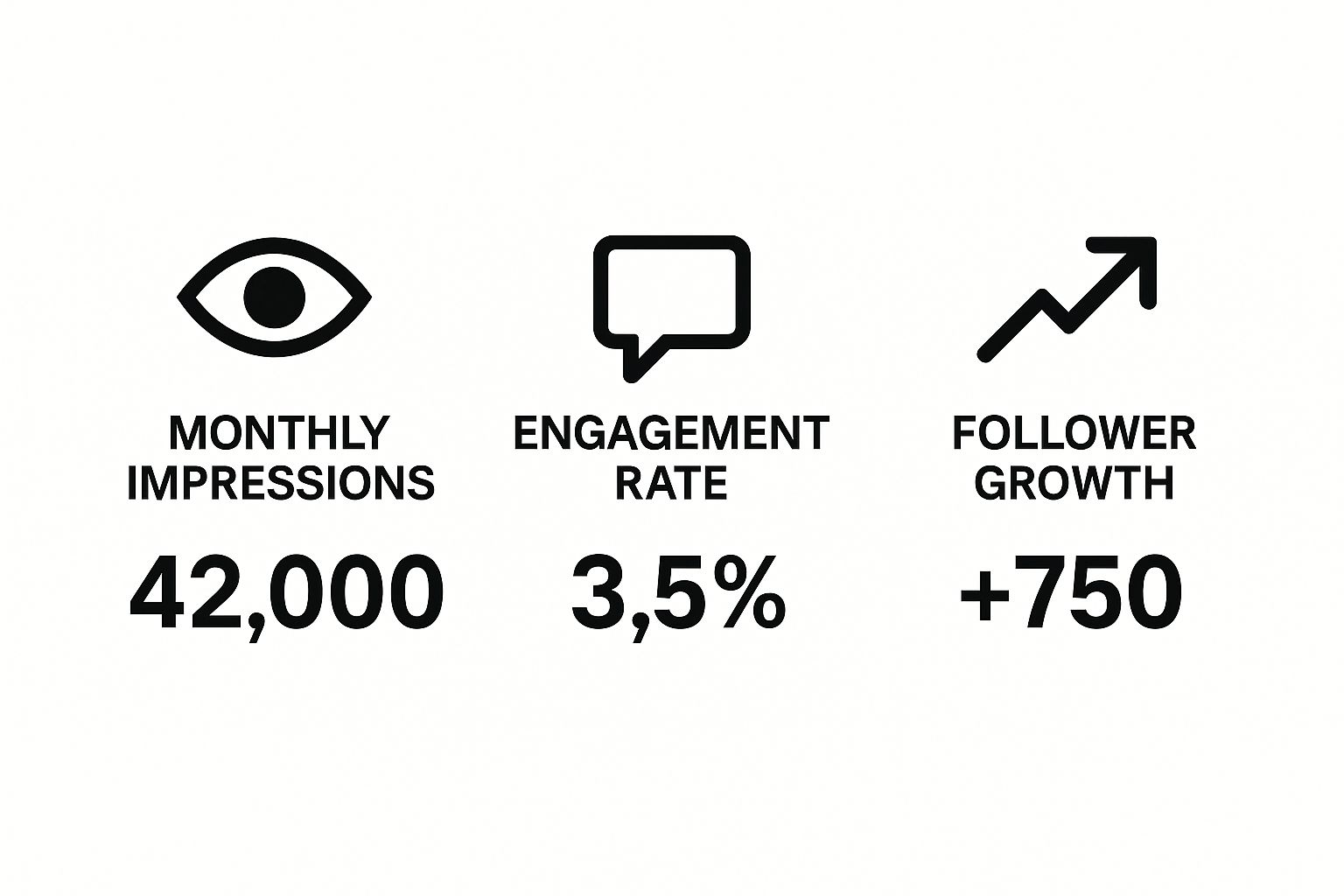
Think of this as your command center. It gives you a clear picture of how your content is doing, showing you trends in impressions, engagement, and who's paying attention. The real gold is hidden in the job titles and companies of the people engaging with your content. Are these the decision-makers you want to reach?
The infographic below breaks down three core metrics you should keep a close eye on.

When you see a healthy balance between impressions, engagement, and follower growth, it’s a strong signal that your content isn't just being seen—it's actually connecting with the right people.
To get a clear picture of your progress, it helps to track the right numbers. Here are some of the key performance indicators that successful LinkedIn influencers monitor to measure their actual impact.
| Metric | Why It Matters | Tracking Method | Benchmark Range |
|---|---|---|---|
| Engagement Rate | Shows how many people interact with your content relative to how many see it. It's the primary indicator of content quality and resonance. | (Likes + Comments + Reposts) / Impressions | 1-3% is good; 3-5% is excellent. |
| Comment Quality | Measures the depth of conversation. Thoughtful comments from industry leaders are more valuable than generic replies. | Manual review of comment sections. | Aim for 10-20% of comments to be from target audience/industry peers. |
| Profile Views | Indicates that your content is compelling enough to make people want to learn more about you. | LinkedIn Analytics > Profile Views | A 15-25% week-over-week increase after a high-performing post is a strong signal. |
| Follower Demographics | Tells you if you're attracting the right audience (e.g., specific job titles, industries, or locations). | LinkedIn Analytics > Followers | Aim for >50% of new followers to match your ideal audience profile. |
| Inbound Connection Requests | Shows that your content is positioning you as a valuable connection. Look for personalized notes. | Review your "My Network" tab. | Quality over quantity; a few relevant requests are better than dozens of generic ones. |
Table: LinkedIn Influence Metrics That Matter Key performance indicators that successful LinkedIn influencers track to measure genuine influence and impact
Tracking these specific metrics helps you move past the ego boost of simple likes and focus on what builds a real, valuable presence on the platform.
Scaling Without Losing Your Soul
As your influence grows, you'll face a new challenge: how to scale your efforts without losing the authenticity that got you noticed in the first place. You can't have deep, meaningful conversations with thousands of people every day. The key is to scale intelligently, not just work harder.
Here’s how you can do it:
- Expand Your Content Formats: If you’ve built a strong following with text-only posts, try mixing things up. Experiment with a carousel post breaking down a complex idea or a short, insightful video. This keeps your content from getting stale and helps you connect with different segments of your audience.
- Systematize Your Engagement: You can't reply to every single comment, and that's okay. Instead, block out specific times in your day to engage with your most valuable followers and key industry players. Prioritize nurturing the relationships that matter most.
- Turn Influence into Opportunity: Once you have a proven track record of engagement and reach, you can start exploring new avenues. You can learn more about how to monetize your LinkedIn presence in our detailed guide. This could open doors to speaking gigs, consulting offers, or strategic brand partnerships.
Ultimately, scaling is about making smart choices to amplify your impact, not just your workload. By focusing on meaningful metrics and expanding strategically, you can build an influential presence that truly lasts.
Your Practical Action Plan for LinkedIn Influence
Alright, talk is cheap. Let's get down to the brass tacks and build a plan you can actually follow. Becoming a recognized voice on LinkedIn won't happen by magic, but with a focused 90-day sprint, you can build serious momentum. This isn't about theory; it's a roadmap to getting real results.
The First 30 Days: Building Your Foundation
Your first month is all about laying the groundwork. Forget about going viral or hitting massive numbers. The real goal here is to establish consistency and signal to both the LinkedIn algorithm and your network what you’re all about.
Weeks 1-2: Profile and Niche Clarity. This is your setup phase. Go through your profile with a fine-tooth comb. Write a headline that screams value, not just your job title. Craft an "About" section that tells a story and helps people connect with you. Most importantly, nail down your content pillars. What are the 3-5 core topics you can talk about week in and week out?
Weeks 3-4: Content and Engagement Cadence. Now it's time to start making some noise. Your mission, should you choose to accept it, is to post 2-3 times per week. The posts don't need to be masterpieces, but they do need to be regular. Just as important, spend at least 15 minutes every day dropping thoughtful, relevant comments on posts from others in your industry. You're not just trying to be seen; you're aiming to become a familiar face in the right conversations.
The Next 30 Days: Gaining Traction
By this point, you should have a small but growing group of followers who are starting to recognize your name in their feed. Month two is about figuring out what’s landing with your audience and pouring a little fuel on that fire.
- Weeks 5-8: Analyze and Amplify. It's time to play detective. Pop open your LinkedIn analytics and see what’s resonating. Which posts sparked the most interesting discussions? What topics got people talking? Use this feedback to guide your content for the next month. This is also a great time to experiment with a new format. Maybe try a simple carousel (you can create one as a PDF) or a short, native video. Your goal is to find that sweet spot—your unique content-market fit.
The Final 30 Days: Scaling and Connecting
This is where your hard work really starts to pay off. You’ve built good habits, you have a content rhythm, and you have a better sense of what your audience craves. Now, let’s scale things up and start building deeper connections.
- Weeks 9-12: Strategic Networking and Collaboration. Identify 5-10 other creators in your niche whose work you admire. Make a conscious effort to engage with their content regularly and add value to their discussions. Then, reach out to one or two with a simple collaboration idea. This could be co-hosting a LinkedIn Audio Event or even just agreeing to share each other's key posts. The aim here is mutual amplification—by tapping into their network, you expose your expertise to a brand new, relevant audience.
This 90-day plan gives you a solid structure, but don't be afraid to adjust it based on what you're seeing. The most important thing is to stay consistent, pay attention to the feedback you're getting, and genuinely try to be helpful.
Ready to make this plan even easier to execute? autoghostwriter provides the tools to create authentic, high-quality posts in a fraction of the time. Stop staring at a blank page and start building your influence today. Discover how we can help at autoghostwriter.com.